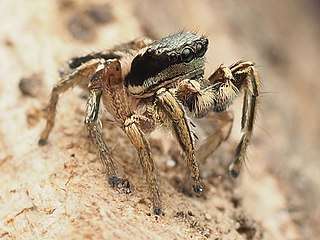
Octavius Pickard-Cambridge FRS was an English clergyman and zoologist. He was a keen arachnologist who described and named more than 900 species of spider from a large collection that he made with contributions sent to him by correspondents from around the world.

Cheliferoides is a genus of jumping spiders that was first described by Frederick Octavius Pickard-Cambridge in 1901. As of June 2019 it contains only three species, found only in Guatemala, Panama, and the United States: C. longimanus, C. planus, and C. segmentatus.

Messua is a spider genus of the family Salticidae.

Metaphidippus is a genus of jumping spiders that was first described by Frederick Octavius Pickard-Cambridge in 1901. The name is combined from Ancient Greek μετά "after, beside" and the salticid genus Phidippus.

Paramarpissa is a genus of North American jumping spiders that was first described by Frederick Octavius Pickard-Cambridge in 1901. Originally considered a synonym of Pseudicius, it was separated into its own genus in 1999.

Paraphidippus is a genus of jumping spiders that was first described by Frederick Octavius Pickard-Cambridge in 1901. The name is a combination of the Ancient Greek "para" (παρά), meaning "alongside", and the salticid genus Phidippus.

Phanias is a genus of jumping spiders that was first described by Frederick Octavius Pickard-Cambridge in 1901. They are similar to members of Marpissa, but have three pairs of spines beneath the first tibia.

Zygoballus is a genus of jumping spiders found in North and South America.

Frederick Octavius Pickard-Cambridge was an English arachnologist. He is sometimes confused with his uncle, Octavius Pickard-Cambridge (1828–1917), who was also an arachnologist and from whom F. O. Pickard-Cambridge picked up his enthusiasm for the study of spiders.
Sillus is a genus of anyphaenid sac spiders first described by Frederick Octavius Pickard-Cambridge in 1900.

Zygoballus rufipes, commonly called the hammerjawed jumper, is a species of jumping spider which occurs in the United States, Canada, and Central America. Adult females are 4.3 to 6 mm in body length, while males are 3 to 4 mm.

Attulus saltator is a species of jumping spider, from the Sitticinae subfamily. It was first described by Frederick Octavius Pickard-Cambridge in 1868 and has a Palearctic distribution, including Great Britain.

Tinus is a genus of nursery web spiders that was first described by Frederick Octavius Pickard-Cambridge in 1901.
Metaphidippus mandibulatus is a species of spider in the family Salticidae from Costa Rica. It is the type species of Metaphidippus. The species name was first published in 1901 by Frederick Octavius Pickard-Cambridge.

Zygoballus tibialis is a species of jumping spider native to Central America. It was first described by the arachnologist Frederick Octavius Pickard-Cambridge in 1901. The type specimens are housed at the Natural History Museum in London.
Pickardinella is a monotypic genus of Mexican long-jawed orb-weavers containing the single species, Pickardinella setigera. The species was first described by Frederick Octavius Pickard-Cambridge under the name Leucauge setigera, and was moved to its own genus in 1951. Physically, they resemble members of Opadometa and Leucauge. Males are very small, only growing up to about 2 millimetres (0.079 in) long. A female has never been found.
Anisaspoides is a monotypic genus of Brazilian bald-legged spiders containing the single species, Anisaspoides gigantea. It was first described by Frederick Octavius Pickard-Cambridge in 1896, and is only found in Brazil.
Evansia is a monotypic genus of dwarf spiders containing the single species, Evansia merens. It was first described by Octavius Pickard-Cambridge in 1901, and has a palearctic distribution.

Habronattus mexicanus is a species of jumping spider in the genus Habronattus. The species was first identified in 1896 in Mexico, after which it is named, originally allocated to the genus Habrocestum. The species has subsequently been identified in locations in North and Central America, as well as islands in the Caribbean Sea. The spider is small, but displays one of the most complex sexual displays, including sophisticated vibatory song patterns.

Zygoballus minutus is a species of jumping spider in the genus Zygoballus that was first identified in Guatemala. The spider has also been found in Mexico, and the distribution may extend across Central America. Zygoballus minutus was first described by George and Elizabeth Peckham in 1898. It is a small spider, which is recalled in the name, which is the Latin for small, ranging in length between 3.5 and 4 mm. The male is distinguished by bands of white hair on the abdomen while the female has a pattern of streaks and bands. The palpal bulbs, which are reddish-brown on the male and yellow on the female, are also a distinguishing feature from other species in the genus.
















